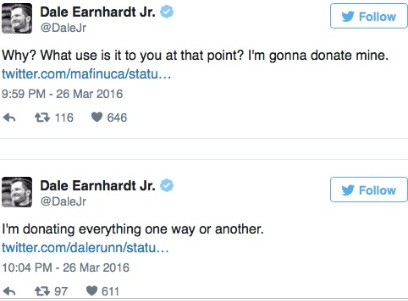
 Photos for Headline Surfer® /
Photos for Headline Surfer® /DAYTONA BEACH, Fla. -- Dale Earnhardt, Jr. is taking a page from the stars of the NFL -- past and present: He's donating his brain to science upon his passing, which he called a "no brainer."
At 41, NASCAR's most popular driver and winner of the 2004 and 2014 Daytona 500 races, has pledged to donate his brain for concussion research when he dies, SB Nation has reported in a March 27 story headlined, "Dale Earnhardt Jr. to donate brain for concussion research."
Earnhardt made the announcement on Twitter when retweeting a Sports Illustrated story on three Oakland Raiders players who plan to donate their brains for Chronic Traumatic Encephalopathy research.
Earnhardt is following the lead of retired Raiders players George Atkinson, George Buehler and Art Thoms who said they will donate their brains as a tribute to the late Raiders quarterback Ken Stabler, who died last year from colon cancer.
After Stabler died on July 8 at age 69 from colon cancer, his brain was examined by researchers at Boston University, who determined Stabler had had high Stage 3 CTE, on a scale of 1 to 4, according to USA Today. After his death, doctors discovered Stabler was suffering from Stage 3 CTE. The Raiders great was inducted posthumously into the 2016 Class of the NFL Hall of Fame.
Medical research has linked repeated blows to head and concussions -- such as those football players, extreme athletes and race car drivers routinely experience -- to CTE, a degenerative brain disease that can lead to dementia, depression and Alzheimer's disease, according to SB Nation.
Head injuries are nothing new to Earnhardt, who suffered a concussion during a May 2002 race and then two more within six weeks in 2012, during races crashes at Kansas Speedway and Talladega Superspeedway, respectively.
Earnhardt self-diagnosed the concussion following the Kansas wreck, but did not seek further medical consultation after being initially checked out and cleared at the track, according to SB Nation. Since Earnhardt's disclosure that he's masked concussions on at least two occasions, NASCAR has revised its policy on how drivers are treated when dealing with a head injury, according to SB Nation.
NASCAR's new concussion policy is as follows: When a driver is involved in an accident and cannot return their car to the garage, they must immediately go to the infield care center, and if there are signs of a head-related injury they will be transported to a hospital. Before returning, a concussed driver must receive clearance by a neurologist.
